|
USDA Announces $9.98 Million in Grants to Strengthen the Specialty Crop Industry
On April 14, USDA announced it has awarded $9.98 million to 14 collaborative, multi-state projects impacting 28 states to enhance the competitiveness of U.S. specialty crops. The funding is made possible through the Specialty Crop Multi-State Program (SCMP), reauthorized by the 2018 Farm Bill.
Funding is awarded competitively to state departments of agriculture that partner with stakeholder organizations in two or more states. In this FY 2022 cycle, USDA received 79 applications and funded 14.
This year’s projects include:
- The California Department of Food and Agriculture’s collaboration with Washington, Oregon, California, Michigan, and Vermont along with primary blueberry researchers and extension professionals will create a user-friendly tool to optimize plant mixes that decrease pests and support habitat creation in blueberries to increase pollination.
- The University of Georgia Research Foundation, Inc. will collaborate with Florida, Georgia, and Alabama to address risks tied to bioaerosols from poultry and cattle production on adjacent property, which has impacted food-born illness outbreaks in fresh produce.
First Local Food Purchase Assistance Cooperative Agreement Signed to Support Local and Regional Farmers
The USDA AMS announced it has signed a cooperative agreement with the Connecticut Department of Agriculture (CT DoAg) under the Local Food Purchase Assistance Cooperative Agreement Program (LFPA). Through the agreement, CT DoAg will receive funding to promote economic opportunities for Connecticut food producers. Under LFPA, CT DoAg will purchase locally grown food through a statewide food bank and a competitive grant process serving Connecticut food pantries, nonprofit organizations, and social service organizations. Connecticut is the second state to enter into a cooperative agreement under the program.
Funding opportunities for state agencies
Local Food for Schools (LFS) Cooperative Agreement Program
Application Due Date: June 17, 2022
USDA AMS will award up to $200 million to states for food assistance purchases of domestic local foods for distribution to schools. This program emphasizes purchasing from historically underserved producers and processors.
Funding for state agencies and Non-Profits
GusNIP Nutrition Incentive Program
Application Due Date: June 30, 2022
The GusNIP Nutrition Incentive Program presents the opportunity to bring together stakeholders from various parts of the food and healthcare systems to foster understanding of how they might improve the health and nutrition status of participating households.
GusNIP Produce Prescription Program
Application Due Date: June 30, 2022
The primary goal and objective of the GusNIP Produce Prescription Program is to demonstrate and evaluate the impact of projects on (1) the improvement of dietary health through increased consumption of fruits and vegetables; (2) the reduction of individual and household food insecurity; and (3) the reduction in healthcare use and associated costs.
Funding for a variety of eligible entities
NIFA Agriculture and Food Research Initiative (AFRI) Sustainable
Agricultural Systems
Application Due Date: July 28, 2022
The USDA’s National Institute of Food and Agriculture’s (NIFA) Agriculture and Food Research Initiative (AFRI) Sustainable Agricultural Systems supports approaches that promote transformational changes in the U.S. food and agriculture system. NIFA seeks creative and visionary applications that take a systems approach for projects that are expected to significantly improve the supply of affordable, safe, nutritious, and accessible agricultural products while fostering economic development and rural prosperity in America.
Funding for qualified lenders
Food Supply Chain Guaranteed Loan Program
Application Due Date: Applications accepted until funds are exhausted
The USDA Rural Development Food Supply Chain Guaranteed Loan Program is a part of USDA's Build Back Better (BBB) initiative, authorized by the American Rescue Plan. This program guarantees loans of up to $40 million for qualified lenders to finance food systems projects, specifically for the start-up or expansion of activities in the middle of the food supply chain. The program will support new investments in infrastructure for food aggregation, processing, manufacturing, storage, transportation, wholesaling, and distribution.
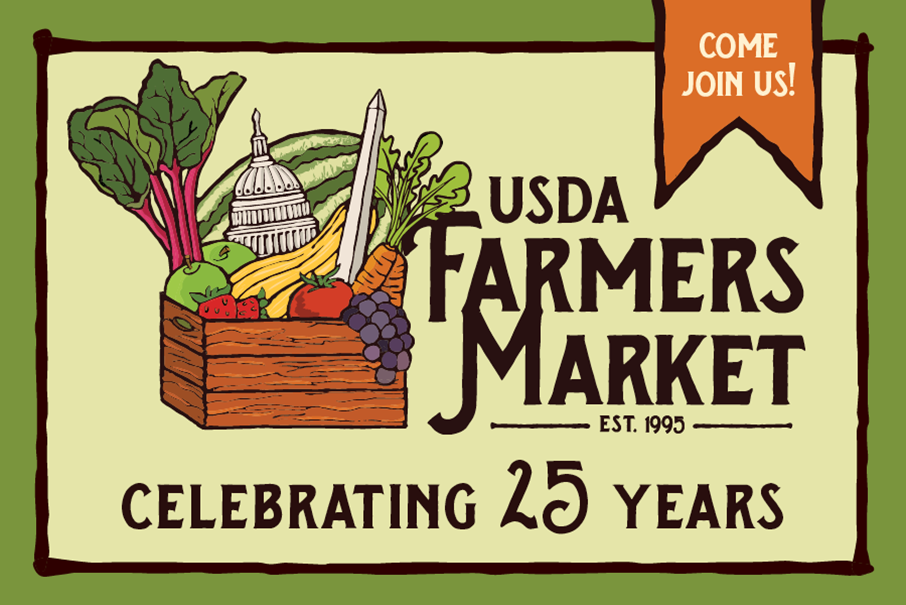
The USDA Farmers Market, located outside the USDA Headquarters in Washington, DC, reopened for its 25th market season on Friday, May 6, 2022, and will run through Friday, October 28, 2022. The market serves as the Department’s own “living laboratory” for farmers market operations across the country with its mission to promote local food and build a community where we work and live. The USDA Farmers Market supports the local economy, increases marketing opportunities for local farmers and small businesses, provides access to an assortment of local and regional sourced products, and increases access to healthy, affordable fresh food in Ward 2 and surrounding areas.
The National Agriculture Statistics Service (NASS) recently released its survey findings on local marketing practices. The purpose of this survey is to produce benchmark data about local food marketing practices. This 2017 Census of Agriculture special study provides data on the marketing of locally and regionally produced agricultural food products.
The results show that over 147,000 U.S. farms produced and sold food locally through direct marketing practices, resulting in $9.0 billion in revenue in 2020. While the number of farms selling directly decreased, the dollar value of such sales increased. The data covers both fresh and value-added foods, such as meat and cheese.
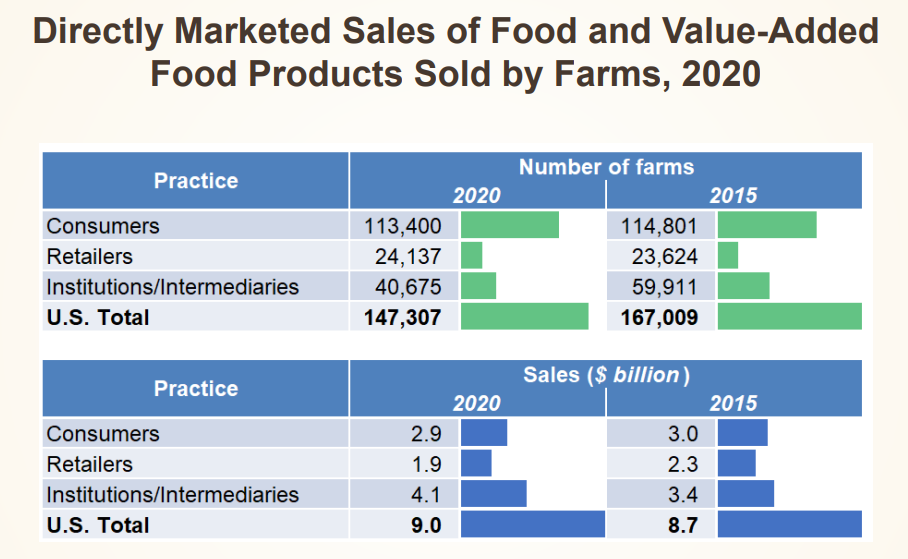 The more than 40,000 farms that sold food directly to institutions and intermediates brought in the most revenue at $4.1 billion; this was followed by operations with direct-to-consumer sales, such as on-farm stores and farmers markets, at $2.9 billion. Sales directly to retailers accounted for $1.9 billion from more than 24,000 operations nationwide.
We’ll be digging into this data more over the next several months. In the meantime, check out the Executive Briefing and Highlights from NASS.
These webinars and consumer food insights are made possible by funding from USDA.
Consumer Food Insights
We’ve published two new Consumer Food Insights in the last few weeks.
An Overview of Online Shopping Trends
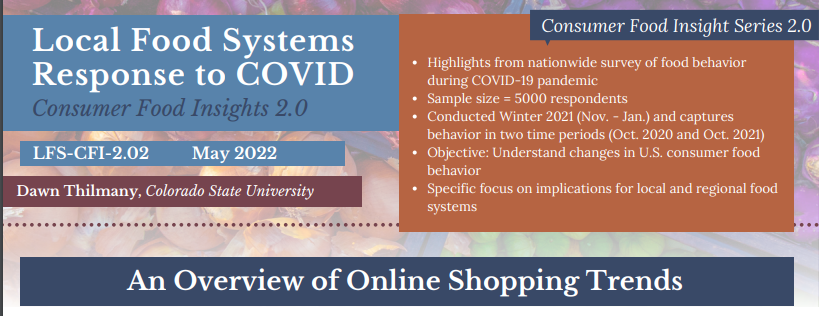 Online food purchasing is a trend that was being tracked for years before the start of the pandemic, but most agree that COVID-19 accelerated the trial and adoption of online purchasing. This Consumer Food Insight shares what we have learned about those trends. In particular, the findings show how use varied among those operating in local and regional food markets.
Changes in Expenditures at Local Food Market Channels in Different Sized Communities
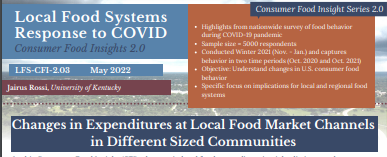 This Consumer Food Insight highlights changes in local food expenditure in eight distinct market channels which are evaluated by community size. These changes are compared at two distinct times: October 2020 and October 2021. These timeframes were chosen because they represent two distinct phases in the progression of consumer response to COVID-19.
Webinars
The recordings for the Local and Regional Food Systems Response to COVID’s March Webinar, The Local Food Environment: Data sharing across local food networks and the April Webinar, Tracking Consumer and Market Trends and the April webinar Tracking Consumer and Market Trends are now available.
Looking Ahead at Innovations and Programs
Targeting Local and Regional Supply Chains
June 10, 2022 at 12:00pm ET
Over the past two years, the Local and Regional Food Systems Recovery and Resilience Project has been working hard to distill key lessons learned from sectors across the food system in response to the pandemic. Join us for the June webinar to hear updates from project team members from our three action teams - Resiliency Playbook, Data and Metrics, and Network of Networks - and how their efforts can help inform LRFS supply innovations and programs in the future.
Each month, we’re highlighting the work of Farmers Market and Local Food Promotion grant recipients.
Barrio Bread
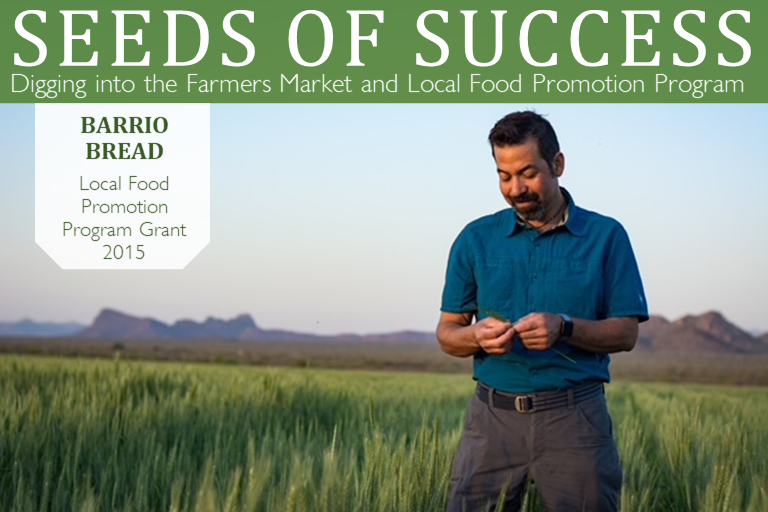 Barrio Bread, and its associated organization, Barrio Grains, turn grain from local farmers in the Tucson, Arizona region into hearty sourdough loaves. Barrio Bread—the organization—came first, but when the founder, Don Guerra, saw there was a demand for local grain and flour as well, he created Barrio Grains. When Don applied for a 2015 Local Food Promotion Program (LFPP) grant, he was operating out of his garage. The grant allowed him to move from selling at the farmers market to setup a brick-and-mortar storefront. There, Don sells directly to community members and wholesale to local restaurants in Tucson.
Philabundance
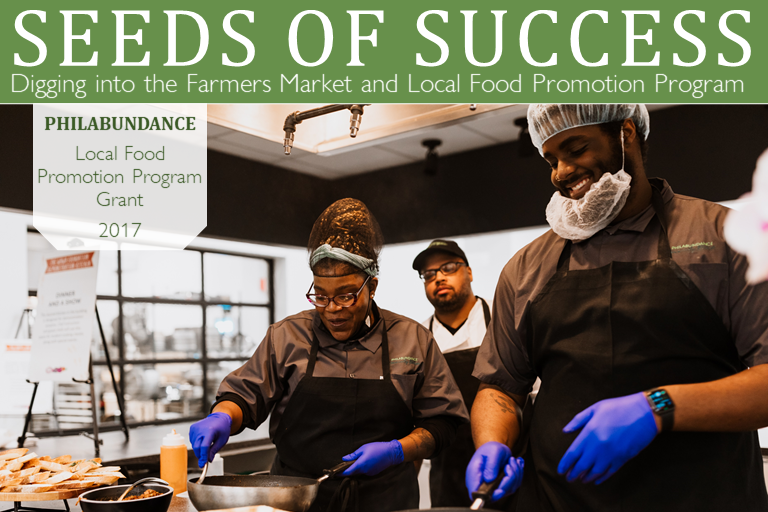 Philabundance, a non-profit based in Philadelphia PA, was founded in 1984 on the idea that no one should go hungry. The organization has been effectively addressing hunger in nine counties in the Delaware Valley of Pennsylvania and four counties in New Jersey for over 30 years, providing nutritious food to needy residents. Philabundance received an LFPP planning grant to determine ways of increasing the availability of local farm products for low-income communities while creating new markets for local farmers.
The grant funded a feasibility study to assess what was needed to increase consumption of local farm products through existing network agencies and identify the local produce and dairy farms that would meet the needs of direct and indirect consumers. The project also piloted collective purchasing by the organization and value-added components as two methods to create purchasing efficiencies. With the support of this grant and other non-USDA programs, Philabundance grew to implement a more effective distribution network.
As a result of this grant project sales for local farmers increased by 175 percent during the grant. Revenue for local farmers jumped from $247,661 prior to the 2017 market season to $682,889 in 2019.
|